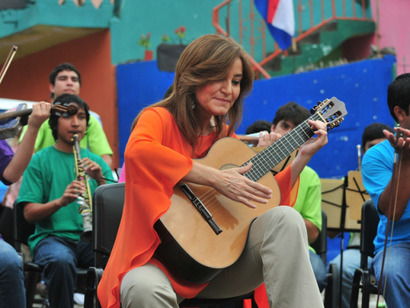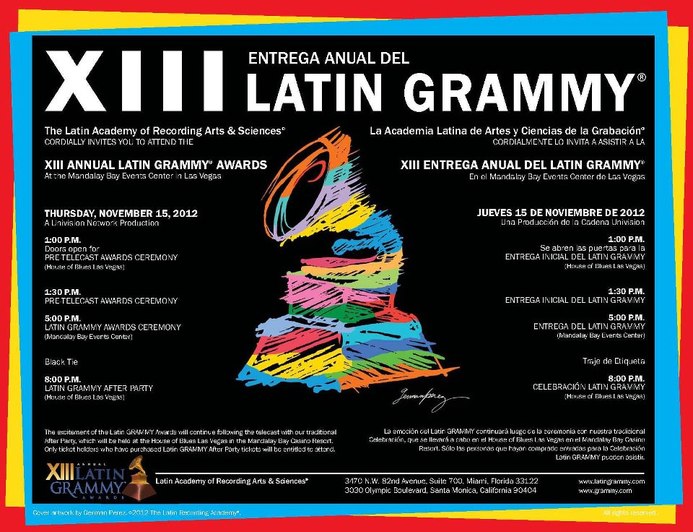
When she released “Salsa Roja” in August (2013), I knew I wanted to review it and interview her. This album is classified as classical guitar. What follows is my interview of this charming, sensitive and immensely talented guitarist.
TR: The world of classical guitar has been dominated by men. The names one immediately considers are Segovia, Bream, Parkening, etc. What is it that you bring to that world?
Berta: I think it is to not just go with genre. You need to gain your audience with every performance. Make them happy by painting whatever images are in your mind. Play your inner music for them and the genre is no longer relevant. Maybe my playing is not as powerful as the men but I think I can bring more sensitivity.
TR: So, then, how would you describe yourself? Berta: I think I would describe myself as a Latin American Classical guitarist. “Salsa Roja” is a tribute to Latin America. I love to search for music of Latin American composers that hasn’t been recorded yet. What is especially enjoyable is to have the living composer there with you as you record.
TR: I dislike over-used phrases like “ambassador” but that is truly the only fitting description of your role in bringing Latin American music to a wider audience. Your last album revealed the beautiful music of Paraguay to listeners who did not ignore the music but were just never aware of it.
Berta: Yes, that is what I hope. I’m glad to hear you say that. There is a rich musical heritage from Latin America that has just not reached the ears of the world. This is why I like using compositions usually unknown to the rest of the world.
TR: Let me ask a tired, old question. When did your music education begin?
Berta: When I was about seven years old, I studied piano and guitar. I won a competition when I was young and I really enjoyed my connection with the guitar. I felt a call I could not ignore.
TR: So you said farewell to the piano?
Berta: I said farewell. Then I was fortunate enough to study with Eduardo Hernandez for about five years. I moved from Paraguay to the United States about 26 years ago. I tried to go home once a year but recently I have been going back five to six times a year to see my mother who is 87 years old.
TR: I’d like to ask you about the “Recycled Instruments Orchestra of Cateura.” What can you tell me about them?
Berta: They have also been called the “Landfill Harmonic Orchestra.” There are 19 members. They come from a poor part of Paraguay outside Asunción. These children wanted to learn music but could not afford instruments. So, their parents searched through landfills to find materials for making instruments. A man named Nicholas Gómez built their instruments with the recycled materials like marmalade tins and pipes. He is the genius behind the orchestration. This started about seven years ago and they were learning music on a patio with no classroom open to them. I wanted to help them build a proper music curriculum. A friend of mine donated about $35,000 worth of instruments for the whole orchestra.
Berta: Oh, they are playing the landfill instruments! We added some guest musicians like a violin, viola, cello and double bass. We did that to soften the sometimes metallic sound. They all worked so very hard. They were meticulous in their attention. They have lots of talent.
TR: Yes! I was surprised that there was a remarkable absence of a metallic sound in these recycled instruments. Who is the youngest or I should say what is the youngest age in the orchestra?
Berta: That’s tough to remember. I think the youngest is about 10 years old.
TR: Who is Noelia?
Berta: Oh, she is a 12 year-old girl who was playing “guitar.” She is a gift for the whole world! When I met her, I saw it in her and two days later gave her my Yamaha guitar. She plays second guitar on “Salsa Roja” on the very first track “Tambito Josefino.” She plays the opening harmonics. [Vocalizes the harmonic response]
TR: The compositions on “Salsa Roja” are surprising. How did an Englishman like Vincent Lindsey-Clark come to write such exquisite “Latin American” music?
Berta: He is a phenomenon! I was touring by myself in England and passed by where he was in rehearsal. His compositions are so good and he was interested in exploring Latin American music. I got to know him and asked him if he would be interested in writing a “salsa with development.” After a short time I received the first part of what would become a suite. Periodically, I would receive more pieces until we wound up with a four-part suite.
TR: I know that it is called a suite but the way he composed connections that tie all four pieces together is almost symphonic. The development of the four note motif beginning in “Danza Galopa” is a brilliant hook. I have to use the word “haunting” to describe the effect. Maybe “memorable” is a better word.
Berta: No, you’re right. The minor 2nd is very sad.
TR: What do you feel when you play this particular piece?
Berta: The 3 against 2 rhythm is very attractive to me. [Intones the rhythm] I have a real affinity with that rhythm. The sadness makes me think of the impoverished landscapes of Paraguay. We have to find a way to change that. That loneliness makes me think of how little we have done and how very hard we must work to change that reality.
TR: What piece touches you the most? I know that is an impossible question to answer.
Berta: Well, I chose them all for a reason. They are all important to me.
TR: An example?
Berta: Well, “El vuelo de la mariposa [Flight of the Butterfly]” starts with the imagery of a butterfly flying from an English garden, being carried on a breeze, then landing in Paraguay. I so relate to that story. It is truly something special. But what really moves me is that it was written for me. It was written for the way I play—the way I make music.
TR: I have really enjoyed talking with you, Berta. I just want you to know that "Dia y Medio" remains one of the most-played CDs in my house.
Berta: I have enjoyed it, too! Thank you, my friend.



















 RSS Feed
RSS Feed
